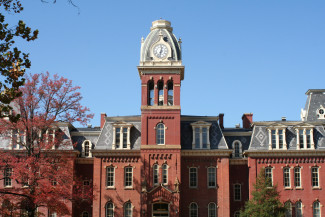
Johns Hopkins UniversityEst. 1876
America’s First Research University
How Boards Lead Small Colleges - Seeking Trustees to Strengthen Colleges Ignored by Most but Needed by Many

When Howard Dean visited the Democratic headquarters where I was volunteering in 2016, I asked: “Hillary has promised to set aside $25 billion for HBCUs and to make public universities tuition-free. What is she going to do for the numerous small private colleges in the rural regions of the country?” His response was, “No one has mentioned them.” When I sent a manuscript about small private colleges to a major publishing house, the editor there responded, “I can’t publish a book about small private colleges because there aren’t enough people in the world who care enough about them to buy a book about them.”
The area of higher education I know best is the five states of central Appalachia: West Virginia and select counties in Kentucky, North Carolina, Tennessee, and Virginia. The colleges I know best in this region are the thirty-five that are members of the Appalachian College Association (ACA). Sadly, of those thirty-five, only eight received A’s or B’s in Forbes’s 2017 ratings reflecting financial stability. One president often told me he expected to return from a vacation to find a padlock on the administration building. Another was seeking a partner institution with which to merge because the institution was facing a payment on a ten-million-dollar debt it couldn’t make. Colleges in Appalachia that continue to nurture children of the mountains too often attract only mediocre leaders as presidents and trustees at a time when they most need strong leaders.
Elizabeth Hayford, retired president of the Associated Colleges of the Midwest, assisted with the development of our book How Boards Lead Small Colleges (Johns Hopkins University Press, 2019). She remains optimistic about the future of small private colleges, but she has worked with colleges that were more financially stable than most of those I’ve known. I remain worried about the future of such colleges across the country; in too many cases, their presidents are primarily concerned about how the colleges can sustain them personally; they are less concerned about what they can do to build a future of strength for their colleges. Too often trustees follow the lead of their president instead of realizing that their responsibility is to lead the president and ensure a future extending beyond the current year.

When I became president of the ACA, a program designed to support faculty teaching in the colleges of central Appalachia, I was repeatedly amazed by the competency and dedication of faculty members. I never met one who had gotten a degree with the specific intent of teaching in a small liberal arts college. However, after a few years in that setting, most realized what an impact they were having on their students and how rewarding being part of such an academic community can be. But, while they controlled their classrooms, they had little authority within the governance structure of their colleges.
In annual meetings with the academic deans in the ACA, I wondered, “Could they become spokespersons for their institutions?” What I soon realized was that these deans were basically at the beck and call of their presidents; they were the ones who received all the assignments the presidents didn’t want to do or didn’t have time to do. The deans seldom had associate or assistant deans. The desks of these deans, many of whom had also retained some teaching responsibilities, had no room for responsibilities from the ACA beyond promoting ACA fellowships.
Foundations and federal agencies gave generously to the ACA; they saw the potential of giving one gift that could benefit thirty-five colleges and their roughly 4,000 faculty and their over 64,000 students—most of whom were first-generation, and more of whom received need-based financial aid. If the nation’s leaders ever become seriously concerned about poverty, a major focus should be on education—the best road out of poverty in every region. But so long as no one points to the problems and offers solutions, the likelihood increases that small, financially insecure, private colleges will witness the light at the end of their tunnel being turned off. Where education offers the most promise for helping the poor escape poverty, it is most ignored.
The many colleges struggling to survive will probably do what those that have closed in recent years did: continue quietly teaching those students who attend until the financial condition of the college warrants the loss of accreditation, without which the college is likely to have to close. In my career, I’ve witnessed five colleges close. Yet, when I have spoken to groups from threatened colleges, their leaders seem to be depending on one thing to save their institutions—prayer. The book Elizabeth and I have just published, How Boards Lead Small Colleges, pleas for colleges to seek strong trustees who can recruit, hire, and work collaboratively with strong presidents. Such leadership may not prevent the closing of already-weak colleges, but it can delay closing for many, during which time thousands of students can receive the kind of education that can move them out of poverty. And such partnerships may actually save some of those colleges hovering near collapse.
Our book is intended to attract strong individuals to serve weak colleges. We hope such potential trustees will believe, as Derek Bok does, “The college that takes students with modest entering abilities and improves their abilities substantially contributes more [to the nation] than the school that takes very bright students and helps them develop only modestly” (from US News and World Report, 2006).
Alice Lee Williams Brown, president emerita of the Appalachian College Association, is the author of Cautionary Tales: Strategy Lessons from Struggling Colleges. Elizabeth Richmond Hayford, the former president of the Associated Colleges of the Midwest, teaches in Northwestern University's Higher Education Administration and Policy Program. Together, they are the authors of How Boards Lead Small Colleges.


